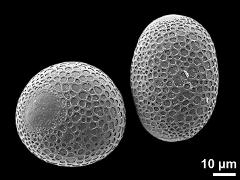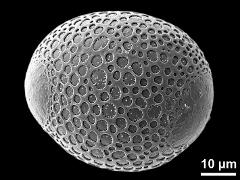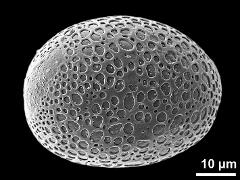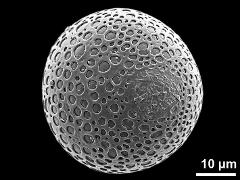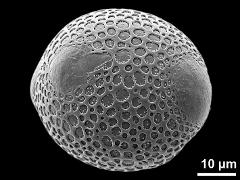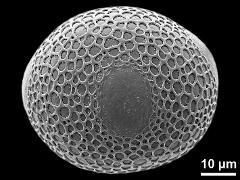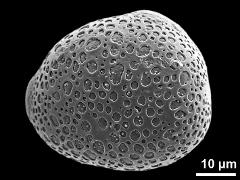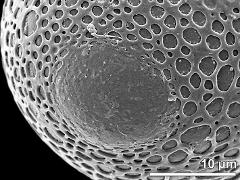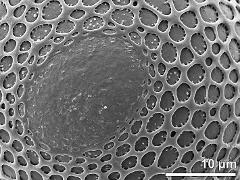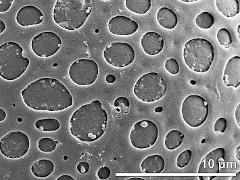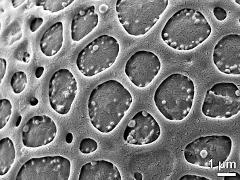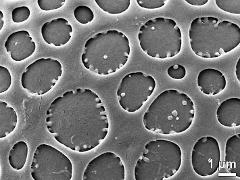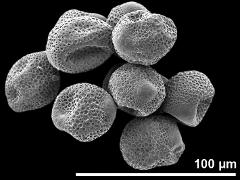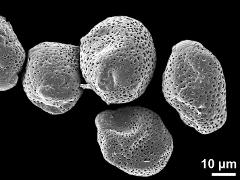Pseudananas sagenarius
Taxonomy: Angiospermae, Poales, Bromeliaceae, Pseudananas
Published: 2016-01-18
Pollen Description
Shape, Size and Aperture
pollen unit: monad, dispersal unit and peculiarities: monad, size (pollen unit): medium-sized (26-50 µm), size of hydrated pollen (LM): -, shortest polar axis in equatorial view (LM): -, longest polar axis in equatorial view (LM): -, shortest diameter in equatorial or polar view (LM): -, longest diameter in equatorial or polar view (LM): -, pollen class: porate, polarity: isopolar, P/E-ratio: oblate, shape: -, outline in polar view: elliptic, dominant orientation (LM): -, P/E-ratio (dry pollen): -, shape (dry pollen): irregular, outline in polar view (dry pollen): irregular, infoldings (dry pollen): irregularly infolded, aperture number: number varies, aperture type: porus, aperture condition: triporate, porate, diporate, aperture peculiarities: -
Ornamentation and Structure
LM ornamentation LM: -, nexine: -, sexine: -, SEM ornamentation SEM: reticulate, foveolate, suprasculpture SEM: -, TEM tectum: -, infratectum: -, foot layer: -, endexine: -, intine: -, wall peculiarities: -, supratectal element: -
Miscellaneous
pollen coatings: -, reserves in cytoplasm: -, cell number: -, Ubisch bodies: absent
Annotations: pollen isopolar to heteropolar, predominantly diporate but also 3 apertures
Author(s) of diagnosis: Halbritter, Heidemarie
Pictures
Picture legend
- hydrated pollen grains - fresh, rehydration (water) & critical point dried & sputter coated with gold, photographer: Halbritter, H.
- hydrated pollen grain - fresh, rehydration (water) & critical point dried & sputter coated with gold, photographer: Halbritter, H.
- hydrated pollen grain - fresh, rehydration (water) & critical point dried & sputter coated with gold, photographer: Halbritter, H.
- equatorial view - fresh, rehydration (water) & critical point dried & sputter coated with gold, photographer: Halbritter, H.
- equatorial view - fresh, rehydration (water) & critical point dried & sputter coated with gold, photographer: Halbritter, H.
- equatorial view - fresh, rehydration (water) & critical point dried & sputter coated with gold, photographer: Halbritter, H.
- 3-porate pollen grain - fresh, rehydration (water) & critical point dried & sputter coated with gold, photographer: Halbritter, H.
- aperture - fresh, rehydration (water) & critical point dried & sputter coated with gold, photographer: Halbritter, H.
- aperture - fresh, rehydration (water) & critical point dried & sputter coated with gold, photographer: Halbritter, H.
- exine surface - fresh, rehydration (water) & critical point dried & sputter coated with gold, photographer: Halbritter, H.
- exine surface - fresh, rehydration (water) & critical point dried & sputter coated with gold, photographer: Halbritter, H.
- exine surface - fresh, rehydration (water) & critical point dried & sputter coated with gold, photographer: Halbritter, H.
- dry pollen grains - dry, sputter coated with gold, photographer: Halbritter, H.
- dry pollen grains - dry, sputter coated with gold, photographer: Halbritter, H.
Literature
Copyright and Citation
Cite this publication as:
Halbritter H. 2016. Pseudananas sagenarius. In: PalDat - A palynological database. https://pc8.botanik.univie.ac.at/pub/Pseudananas_sagenarius/300301;jsessionid=DD2C576A42AF5B1992ACC506D4FDF3A5; accessed 2025-01-25

